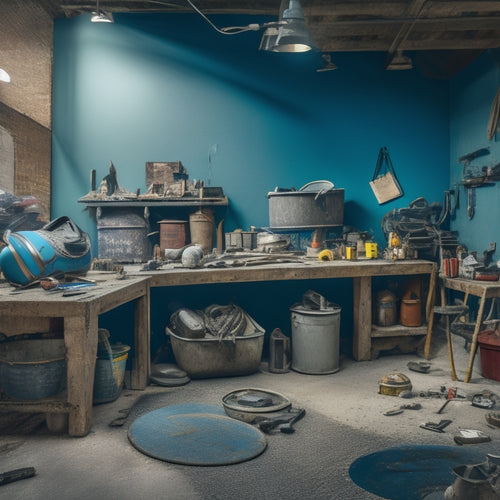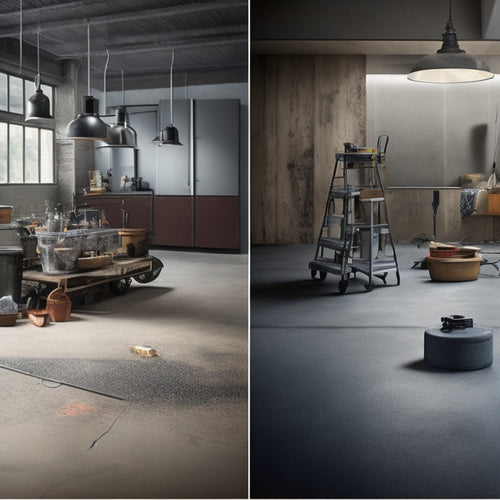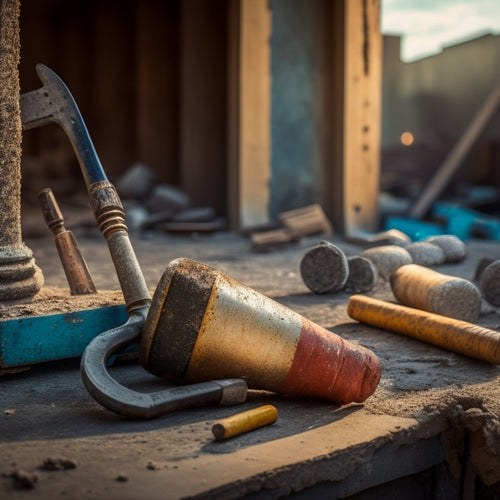
7 Must-Have Tools for Premixed Concrete Projects
Share
You'll need seven essential tools to guarantee a successful premixed concrete project. First, invest in mixing and measuring tools like a concrete mixer, measuring cups, and a mixing paddle. Next, gather finishing and smoothing tools such as trowels, floats, and edgers. Don't forget safety gear like heavy-duty gloves, safety goggles, and a dust mask. You'll also need cutting and breaking tools like diamond blades and hydraulic breakers, as well as tamping and compaction equipment like vibration plates. Finally, prepare formwork supplies, cleaning accessories, and protective gear. As you get started, you'll discover the importance of each tool in achieving a flawless concrete finish.
Key Takeaways
• Essential mixing and measuring tools, including a concrete mixer, hand mixer, and measuring cups, ensure accurate material proportions and uniform consistency.
• Concrete finishing and smoothing tools, such as trowels, floats, and edgers, are necessary for achieving a smooth, even finish and defined edges.
• Cutting and breaking equipment, including diamond blades and hydraulic breakers, are required for precise cutting and effective demolition and renovation.
• Tamping and compaction equipment, such as vibration plates and plate compactors, are vital for compacting large areas and eliminating air pockets.
• Safety gear, including hard hats, safety glasses, and gloves, is crucial for protecting workers from chemicals, debris, and other hazards.
Essential Mixing and Measuring Tools
When preparing to mix premixed concrete, you'll need to guarantee you have the following essential mixing and measuring tools on hand to achieve accurate and consistent results.
A mixing bucket or drum with a sturdy handle is a must-have, as it allows for efficient and thorough mixing. You'll also need a mixing stick or trowel to scrape the sides and bottom of the bucket, making sure all ingredients are well incorporated.
Measuring accuracy is vital in concrete mixing, so invest in a digital scale or measuring cups to confirm precise measurements. A mixing paddle or drill with a mixing attachment can help you achieve uniform consistency and prevent lumps.
Don't forget a pair of heavy-duty gloves and safety goggles to protect yourself from harsh chemicals and flying debris.
Concrete Finishing and Smoothing Tools
You'll need a range of concrete finishing and smoothing tools to achieve a professional-looking finish, including tamping tools, edgers, and floats. These tools are essential for achieving a smooth, even surface that's free from imperfections.
Tamping tools, such as bull floats and hand tamps, help to remove air pockets and excess water from the concrete, while edgers and floats are used to create a clean, defined edge and a smooth finish.
When it comes to smoothing techniques, you'll want to use a combination of finishing methods to achieve the desired result. This may include using a power trowel or a manual trowel to smooth out the surface, followed by a series of finishing passes with a float or edger.
It's also important to use the right type of finishing tool for the specific type of concrete you're working with, as some tools are better suited for certain types of mixes.
Safety and Protective Gear Essentials
Before starting any premixed concrete project, assure you have the necessary safety and protective gear essentials to prevent injuries and protect yourself from hazardous materials.
You'll need to develop and follow strict safety protocols to avoid accidents and assure a successful project.
First, invest in high-quality protective equipment such as hard hats, safety glasses, and earplugs to shield yourself from falling debris, chemical splashes, and loud noises.
You'll also need durable gloves to prevent skin irritation and cuts from handling rough materials.
Don't forget to wear long-sleeved shirts, long pants, and steel-toed boots to protect your skin and feet from harsh substances and heavy objects.
Additionally, consider wearing a dust mask or respirator when working with powdered concrete mixes or in confined spaces to prevent respiratory issues.
Assure you have a first-aid kit on site, stocked with essentials like bandages, antiseptic wipes, and pain relievers.
Concrete Cutting and Breaking Tools
Precision is key when it comes to shaping and resizing premixed concrete, and that's where concrete cutting and breaking tools come into play. You'll need the right equipment to make precise cuts and breaks without compromising the structural integrity of the concrete. Here are some essential tools you should have in your arsenal:
| Tool | Description |
|---|---|
| Diamond Blades | Designed for cutting through concrete, these blades are equipped with diamond-coated edges for maximum durability and precision. |
| Hydraulic Breakers | These powerful tools use hydraulic pressure to break up concrete, making them ideal for demolition and renovation projects. |
| Concrete Saws | Perfect for making straight cuts in concrete, these saws are available in electric, gas, and hydraulic models. |
| Jackhammers | Also known as demolition hammers, these tools use pneumatic or electric power to break up concrete and asphalt. |
When working with concrete cutting and breaking tools, it's vital to prioritize safety. Always wear protective gear, including gloves, safety glasses, and a dust mask. Additionally, verify you're following the manufacturer's instructions and taking regular breaks to avoid fatigue. With the right tools and a focus on safety, you'll be able to tackle even the most complex concrete projects with confidence.
Tamping and Compaction Equipment
Now that you've successfully cut and broken your premixed concrete, it's time to focus on tamping and compacting the material to guarantee a stable and even surface. This vital step confirms that your concrete slab or structure can withstand the intended loads and environmental conditions.
To achieve the best compaction, you'll need the right tamping and compaction equipment. Vibration plates are a fundamental tool for compacting large areas of concrete. These machines use high-frequency vibrations to eliminate air pockets and densify the material.
Plate compactors, on the other hand, are ideal for compacting smaller areas, such as edges, corners, and tight spaces. They're also effective for compacting concrete in areas with limited access.
When operating tamping and compaction equipment, it's important to follow the manufacturer's instructions and take necessary safety precautions. Wear protective gear, including gloves, safety glasses, and a dust mask, to minimize the risk of injury.
Confirm the equipment is properly maintained and in good working condition to prevent accidents and achieve the best results. By using the right tamping and compaction equipment, you'll be able to achieve a strong, durable, and even concrete surface that meets your project's requirements.
Finishing and Texturing Tools Required
You'll need a range of finishing and texturing tools to achieve the desired appearance and functionality of your premixed concrete surface, whether it's a smooth, high-gloss finish or a textured, slip-resistant surface. The right tools will help you accomplish the desired finishing techniques and texture patterns. Here are some essential finishing and texturing tools you'll need:
| Tool | Description | Purpose |
|---|---|---|
| Trowel | A flat, handheld tool used to apply and smooth out concrete | Achieve a smooth, flat finish |
| Edger | A tool used to create a clean, defined edge around the concrete surface | Create a professional-looking edge |
| Float | A tool used to smooth and flatten the concrete surface | Achieve a smooth, flat finish |
| Broom | A tool used to create a textured, slip-resistant surface | Create a slip-resistant surface |
| Stamp | A tool used to create a patterned or textured surface | Achieve a decorative finish |
Remember to always follow safety guidelines when working with premixed concrete, and use the right tools for the job to guarantee a high-quality finish. By having the right finishing and texturing tools, you'll be able to achieve the desired appearance and functionality for your premixed concrete project.
Cleaning and Washing Accessories Needed
During the premixed concrete project, it's vital to have the right cleaning and washing accessories on hand to remove excess cement, dirt, and other debris from your tools and equipment. This guarantees your tools remain in good condition, prevents damage, and maintains a safe working environment.
You'll want to adopt effective cleaning techniques and washing methods to get the job done efficiently.
Here are some essential cleaning and washing accessories you should have:
-
Pressure washer: A high-pressure washer is perfect for removing stubborn cement and dirt from your tools and equipment.
-
Wire brushes: Stiff-bristled wire brushes are great for scrubbing away dried cement and debris from tools and surfaces.
-
Detergent and degreasers: Mild detergents and degreasers help break down and remove grease, oil, and other substances from your tools and equipment.
- Water source: A reliable water source is necessary for washing and cleaning your tools and equipment.
Frequently Asked Questions
Can I Use a Regular Drill for Mixing Concrete?
Can you use a regular drill for mixing concrete?
Technically, yes, but it's not recommended. A regular drill lacks the torque and power needed for effective mixing, leading to uneven consistency and potential motor burnout.
Instead, opt for a heavy-duty drill or a mixing drill specifically designed for concrete.
Employ proper mixing techniques, such as slow and steady movements, to guarantee a safe and successful project.
How Do I Remove Dried Concrete From My Tools?
When tackling concrete removal from your tools, prioritize safety and efficiency.
Start by scraping off excess concrete with a putty knife or wire brush, taking care not to scratch the tool's surface.
Next, soak the tool in a mixture of warm water and mild detergent.
For stubborn concrete, try applying a concrete removal solution or a vinegar-based solution.
Always wear protective gear, including gloves and safety glasses, when using these tool cleaning methods.
Can I Mix Concrete in Extremely Cold Weather?
You're not the only one who's faced this dilemma - many contractors have mixed concrete in freezing temperatures, only to end up with subpar results.
But, you can avoid this fate by taking cold weather precautions.
When mixing concrete in extremely cold weather, you'll need to adjust your concrete mixing techniques.
Specifically, use hot water, insulate your mixing area, and consider using accelerators to speed up the setting process.
Is It Necessary to Cure Concrete in Hot Weather?
When you're working with concrete in hot weather, you'll want to prioritize curing to guarantee proper concrete hydration.
High temperatures can accelerate hydration, leading to weak and brittle concrete. If you don't cure it correctly, you'll risk compromising the structure's integrity and safety.
To avoid this, you should maintain a consistent temperature, use evaporation retarders, and apply curing compounds to prevent rapid moisture loss. This will help ensure your concrete cures strong and durable.
Can I Use Premixed Concrete for Decorative Projects?
Imagine a canvas of concrete, awaiting your artistic touch.
You're wondering if premixed concrete can be the medium for your decorative projects. The answer is yes, you can use premixed concrete for decorative projects, but be aware that it may not offer the same level of customization as mixing from scratch.
However, premixed options can still provide a solid foundation for your creative vision, and many decorative concrete products are specifically designed for this purpose, ensuring a safe and durable outcome.
Conclusion
You've got the right tools for your premixed concrete project. With these 7 must-haves, you'll be well-equipped to mix, finish, and perfect your concrete creation.
Did you know that the global concrete market is projected to reach 14.1 billion tons by 2025? That's a lot of concrete!
With the right tools, you'll be contributing to that staggering statistic.
Now, get mixing and make your mark on the concrete landscape!
Related Posts
-

What Tools Do You Need for Concrete Flooring
You'll need a thorough arsenal of specialized tools to achieve a high-quality, professional-looking concrete floor, i...
-

Top Tools for Revamping Old Concrete Floors
You'll need a range of tools to revamp your old concrete floor, starting with epoxy, acrylic, or polyurethane paint, ...
-

5 Tips for Splitting Concrete With Second-Hand Tools
When splitting concrete with second-hand tools, you'll need to be strategic to avoid wasting time, money, and putting...


